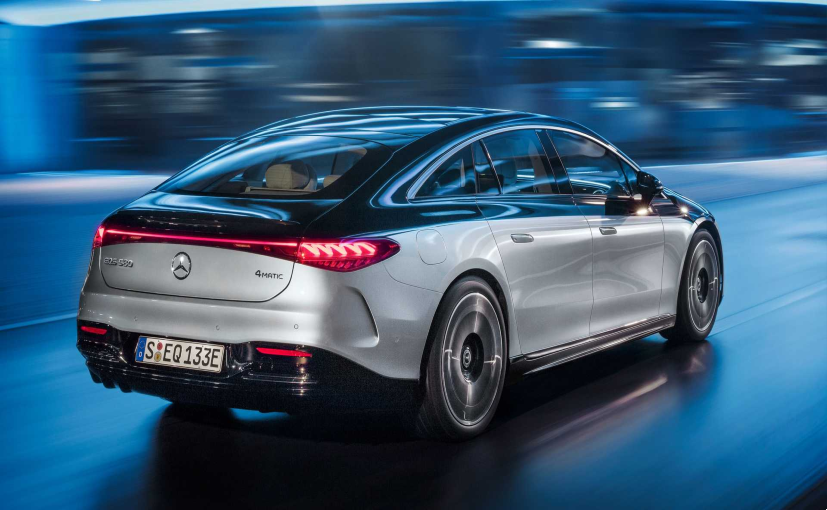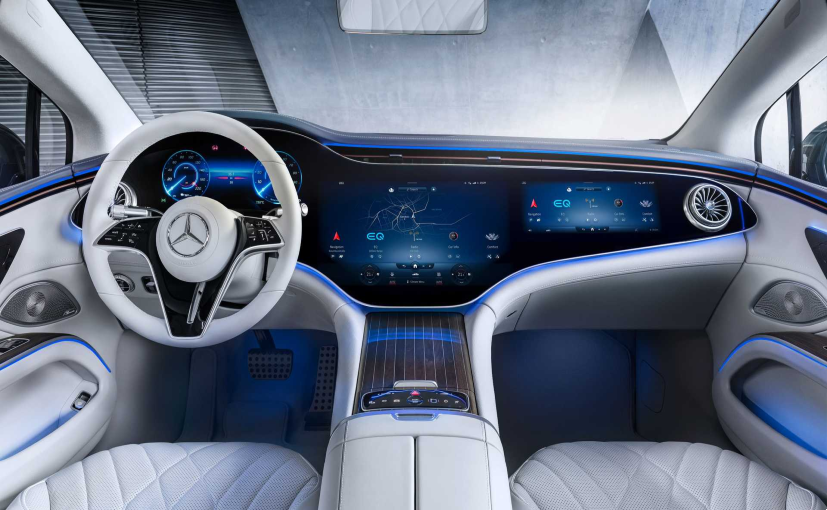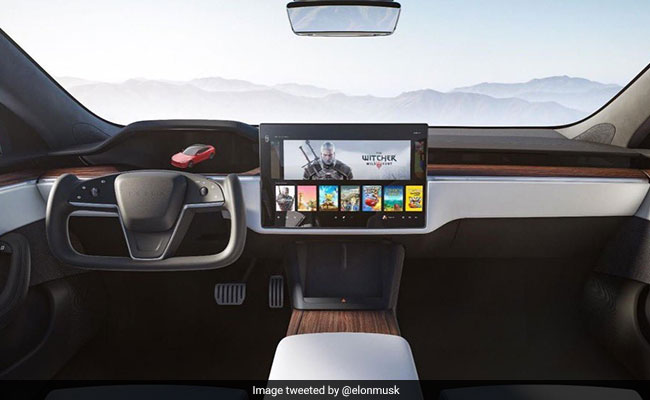Mercedes-Benz EQS vs Tesla Model S: Specifications Comparison

Highlights
- The Mercedes-Benz EQS is the flagship electric vehicle from the company
- The Tesla Model S so far heavily monopolised this segment
- The EQS offers a max range of 770km compared to Model S' max 837km range
Mercedes-Benz has finally pulled the wraps off its long-anticipated flagship electric vehicle - EQS. The Stuttgart-based luxury carmaker has revealed everything there is to know about this S-Class of electric sedans and visually, and on paper, the new Mercedes-Benz EQS certainly looks very impressive. However, the car is entering a space that was so far heavily monopolised by the very popular Tesla Model S. So, can the German beat the American in its own game? Well, let's look at all the facts and figures and see where does the new EQS stand against the Model S on paper.
Also Read: New Mercedes-Benz EQS Breaks Cover
Design and Dimensions

With a total length of 5216 mm the Mercedes-Benz EQS is 236 mm longer than the Model S, while its wheelbase is 250 mm longer at 3210 mm
Now looks are subjective so we won't get too much into that, however, you have to agree that the new EQS is a handsome looking car. Now the Tesla Model S is certainly a good-looking car, it has always been known for its futuristic looks and sporty stance. However, the new EQS is no different either, it comes with those signature Mercedes lines and that stance that's all about luxury, especially in the Maybach-inspired dual-tone paint scheme.
| Dimensions | Mercedes-Benz EQS | Tesla Model S |
|---|---|---|
| Length | 5216 mm | 4980 mm |
| Width | 1926 mm | 1964 mm |
| Height | 1512 mm | 1440 mm |
| Wheelbase | 3210 mm | 2960 mm |

The Tesla Model S is wider than the EQS by 38 mm at 1964 mm, but shorter by 72 mm at a total height of 1440 mm.
In terms of dimensions, the EQS takes the lead here. At a total length of 5216 mm it's 236 mm longer than the Model S, while its wheelbase is 250 mm longer at 3210 mm, which essentially translates to a more cabin room. Having said that, the Model S is wider than the EQS by 38 mm at 1964 mm, but shorter by 72 mm at a total height of 1440 mm.
Also Read: Mercedes-Benz Reveals Technical Specifications Of The EQS
Electric Powertrain and Battery

Both variants of the new Mercedes-Benz EQS are powered by a 108.7-kilowatt-hour lithium-ion battery.
The Mercedes-Benz EQS is available in two trims - EQS 450+ and EQS 580 4MATIC and both come with a Permanently excited synchronous motor (PSM). The EQS 450+ is the base variant that features a single electric motor on the rear axle for a total of 328 bhp and 568 Nm of peak torque. The EQS 580 4MATIC is an all-wheel-drive (AWD) range-topping trim and gets an electric motor on both front and rear axles. Total output in combination here is 516 bhp and a whopping 855 Nm of peak torque, good for a 4.1 seconds sprint to 100 kmph from a standstill.
| Specifications | Mercedes-Benz EQS | Tesla Model S |
|---|---|---|
| Electric Motor | Permanently excited synchronous motor (PSM) | 3-phase AC induction motor |
| Max Power | 328 bhp / 516 bhp | 660 bhp / 1006 bhp |
| Max Torque | 568 Nm / 855 Nm | NA |
| Transmission | Automatic | Automatic |
The Tesla Model S, on the other hand, is also offered in three variants - Long Range, Plaid and Plaid+, however unlike the EQS all trims get All-Wheel Drive (AWD). The Long Range trim comes with dual electric motors, one attached to each axle and they offer a combined output of 660 bhp. The Plaid and Plaid+ variants come with three electric motors and offer an output of over 1006 bhp.

The Tesla Model S comes with a 100 kWh Lithium-Ion battery pack and a maximum range of up to 837 km with the Plaid+ trim
Battery and Charging
The Mercedes-Benz EQS comes with a 107.8 kWh Lithium-Ion battery, promising a 770 km WLTP cycle certified drive range on a full charge. However, the carmaker has not provided detailed variant-wise range options for the model. The car comes with a standard onboard charger of 11 kW with an optional 22 kW charger. However, it does support DC fast charging of 200 kW, and using that 15 minutes of charge time will give you a range of up to 300 km.
Also Read: Tesla Unveils New Model S & Model X With Futuristic Interiors
| Specification | Mercedes-Benz EQS | Tesla Model S |
|---|---|---|
| Battery | 107.8 kWh Lithium-Ion | 100 kWh Lithium-Ion |
| Max Range | 770 km | 837 km |
| Onboard Charger Capacity | 11 kW | 11.5 kW |
| DC Fast Charger Capacity | 200 kW | 250 kW |

The MBUX Hyperscreen is massive a 56-inch-wide pane of curved glass that houses three individual OLED displays.
The Tesla Model S, at the same time, comes with a 100 kWh Lithium-Ion battery pack. The Long Range variant comes with a maximum range of up to 663 km, while the more powerful Plaid trim offers a range of 628 km. As for the Plaid+ variant, on paper, the model can offer a maximum range of up to 837 km on a single charge, which is 67 km more than the claimed range of the EQS. As for fast charging capacity, the Model S supports up to 250 kW.

The Tesla Model S' 17-inch system system allows you to do a lot of things like play a video game or watch a movie and is compatible with wireless controllers
Conclusion
On paper, the Tesla Model S manages to surpass the Mercedes-Benz EQS both in terms of performance and driving range. The EQS does offer a host of creature comforts, including a massive 56-inch wide pane of curved glass that houses three individual OLED displays, including one for the front passenger. The Model S, on the other hand gets 3 separate displays - one large 17-inch display as the central command, a second one for instrumentation behind the steering and a third one at the back for the rear seat entertainment. Tesla's system also allows you to watch a movie or play video games and it is compatible with wireless controllers. So, essentially both cars address a different set of buyers and we believe that will allow them to co-exist in an EV market that is still growing.
Last Updated on April 16, 2021
Related Articles
Latest News
Popular Mercedes-Benz Models
 Mercedes-Benz G-ClassEx-Showroom Price₹ 2.55 Crore
Mercedes-Benz G-ClassEx-Showroom Price₹ 2.55 Crore Mercedes-Benz E-ClassEx-Showroom Price₹ 78.5 - 92.5 Lakh
Mercedes-Benz E-ClassEx-Showroom Price₹ 78.5 - 92.5 Lakh Mercedes-Benz A-Class LimousineEx-Showroom Price₹ 46.05 - 48.55 Lakh
Mercedes-Benz A-Class LimousineEx-Showroom Price₹ 46.05 - 48.55 Lakh Mercedes-Benz GLE-ClassEx-Showroom Price₹ 96.4 Lakh - 1.15 Crore
Mercedes-Benz GLE-ClassEx-Showroom Price₹ 96.4 Lakh - 1.15 Crore Mercedes-Benz C-ClassEx-Showroom Price₹ 60 - 66 Lakh
Mercedes-Benz C-ClassEx-Showroom Price₹ 60 - 66 Lakh Mercedes-Benz GLSEx-Showroom Price₹ 1.32 - 1.37 Crore
Mercedes-Benz GLSEx-Showroom Price₹ 1.32 - 1.37 Crore Mercedes-Benz GLCEx-Showroom Price₹ 74.45 - 75.45 Lakh
Mercedes-Benz GLCEx-Showroom Price₹ 74.45 - 75.45 Lakh Mercedes-Benz GLA-ClassEx-Showroom Price₹ 51.75 - 56.9 Lakh
Mercedes-Benz GLA-ClassEx-Showroom Price₹ 51.75 - 56.9 Lakh Mercedes-Benz S-ClassEx-Showroom Price₹ 1.77 - 1.86 Crore
Mercedes-Benz S-ClassEx-Showroom Price₹ 1.77 - 1.86 Crore Mercedes-Benz EQSEx-Showroom Price₹ 1.55 Crore
Mercedes-Benz EQSEx-Showroom Price₹ 1.55 Crore Mercedes-Benz GLBEx-Showroom Price₹ 63.8 - 69.8 Lakh
Mercedes-Benz GLBEx-Showroom Price₹ 63.8 - 69.8 Lakh Mercedes-Benz EQBEx-Showroom Price₹ 70.9 - 77.5 Lakh
Mercedes-Benz EQBEx-Showroom Price₹ 70.9 - 77.5 Lakh Mercedes-Benz G 580 EVEx-Showroom Price₹ 3 Crore
Mercedes-Benz G 580 EVEx-Showroom Price₹ 3 Crore Mercedes-Benz EQS SUVEx-Showroom Price₹ 1.28 - 1.41 Crore
Mercedes-Benz EQS SUVEx-Showroom Price₹ 1.28 - 1.41 Crore Mercedes-Benz EQE SUVEx-Showroom Price₹ 1.39 Crore
Mercedes-Benz EQE SUVEx-Showroom Price₹ 1.39 Crore Mercedes-Benz EQAEx-Showroom Price₹ 66 Lakh
Mercedes-Benz EQAEx-Showroom Price₹ 66 Lakh Mercedes-Benz CLE CabrioletEx-Showroom Price₹ 1.1 Crore
Mercedes-Benz CLE CabrioletEx-Showroom Price₹ 1.1 Crore














